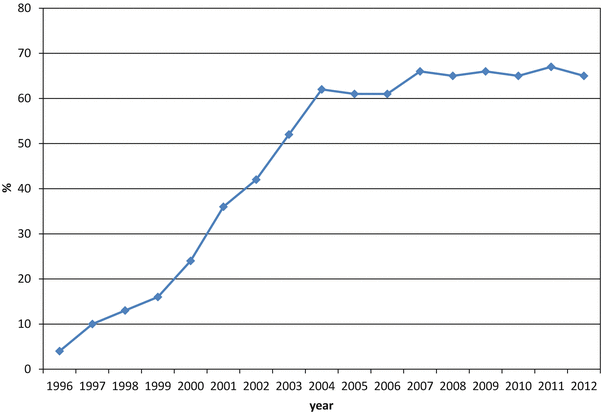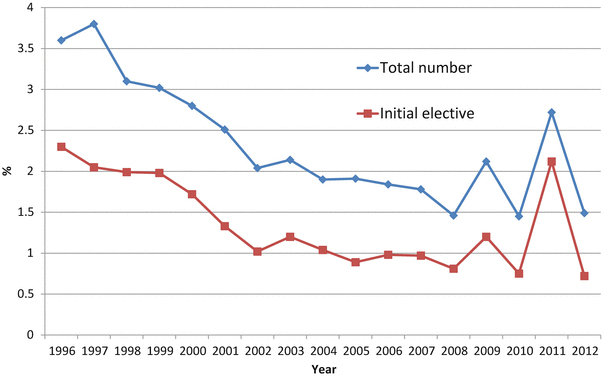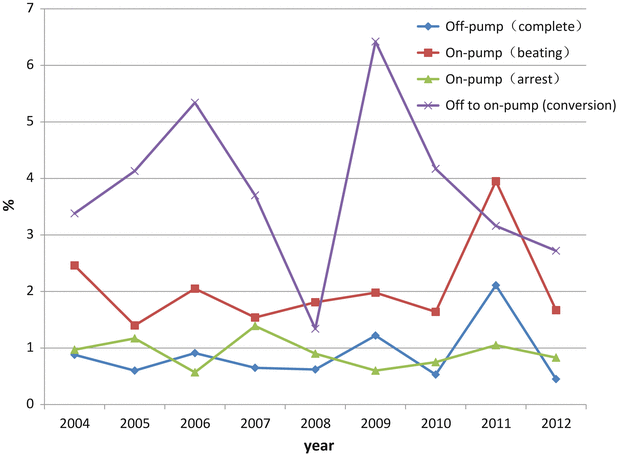Total number
14,999
Isolated CABG
10,658 (71 %)
Concomitant CABG
4,341 (29 %)
Isolated CABG
Initial elective: 8,983
Other than initial elective: 1,675
Off pump: 5,865
Off pump: 880
On pump: 3,118
On pump: 795
(Off-pump rate: 65 %)
(Off-pump rate: 53 %)
2.3 Changes in OPCAB Rate of Initial Elective Isolated CABG
Figure 2.1 shows the changes in OPCAB rates over the previous 17 years from 1996 to 2012. Since 1996, the number of OPCAB cases had remarkably increased annually until 2004, reaching 62 %. Although there was a slight decrease in 2005, 65 % of patients who underwent initial elective isolated CABG received OPCAB in 2012, indicating a persistently high rate.


Fig. 2.1
Changes in OPCAB rate of initial elective isolated CABG
2.4 Surgical Procedures of Initial Elective Isolated CABG
Regarding initial elective isolated CABG, a total of 2,038 patients (22.7 %) underwent on-pump CABG with cardiac arrest, 1,080 patients underwent on pump with cardiac beating (12.0 %), and OPCAB was performed in 5,865 cases (65.3 %). In those OPCAB cases, 5,718 patients (97.5 %) underwent off pump until the end of operation, and the remaining 147 cases required conversion from off-pump to on-pump CABG. This conversion rate was 2.5 %, which was lower than 3.8 % in 2011 as shown in Table 2.2.
Table 2.2
Surgical procedures of initial elective isolated CABG
Total number of initial elective | 8,983 (100 %) |
On pump (cardiac arrest) | 2,038 (22.7 %) |
On pump (cardiac beating) | 1,080 (12.0 %) |
Off pump (total number) | 5,865 (65.3 %) |
Off pump (complete) | 5,718 |
On pump (conversion) | 147 |
Off pump (complete rate) | 97.5 % |
Off to on pump (conversion rate) | 2.5 % (previous year: 3.8 %) |
2.5 Outcome According to Procedures
The mortality rate in patients who underwent isolated CABG was 1.49 %, which was much lower than that in 2011, and that for isolated initial elective CABG cases was 0.72 %, achieving the best result since the survey was first conducted. The mortality rate for complete OPCAB was 0.45 %, which is the lowest since this less invasive procedure was introduced. In addition, the mortality rate for conversion from off- to on-pump cases was 2.72 %, which is lower than those of previous years (Table 2.3).
Table 2.3
Outcome according to procedures
Mortality for isolated CABG | 1.49 % (previous year: 2.72 %) |
Mortality for initial elective CABG | 0.72 % (previous year: 2.12 %) |
On pump (cardiac arrest) | 0.83 % |
On pump (cardiac beating) | 1.67 % |
Off pump (total) | 0.51 % |
Off pump (complete) | 0.45 % (previous year: 2.11 %) |
On pump(conversion) | 2.72 % (previous year: 3.16 %) |
2.6 Changes in Mortality of CABG
The changes in mortality since 1996 are shown in Fig. 2.2. The clinical results improved remarkably annually; the operative mortality rate of isolated CABG cases decreased to 1.49 % and that of initial elective patients decreased to 0.72 % in 2012. These are the best results obtained since the surveys were introduced 30 years previously.


Fig. 2.2
Changes in mortality of CABG
2.7 Changes in Mortality According to Procedures: Isolated Initial Elective CABG
Figure 2.3 shows the changes in mortality according to procedures since 2004. Generally, the mortality rate of off- to on-pump conversion cases was high. In contrast, the mortalities of on pump (arrest) and off pump (complete) were lower, with the lowest rate of 0.45 % in complete OPCAB in 2012.






Fig. 2.3
Changes in mortality according to procedures: isolated initial elective CABG
Stay updated, free articles. Join our Telegram channel

Full access? Get Clinical Tree


